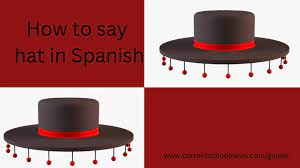There are a lot of things to learn in Spanish. It may seem overwhelming at first, but it’s helpful to start with the basics.
It’s important to know how to say hello and goodbye in Spanish. This way, you can make a good impression on your Spanish-speaking friends!
You should also remember that the letter g in Spanish is pronounced like an English “h”. This is important because it can change the meaning of words!
1. Sombrero
The word for hat in Spanish is sombrero. This is also the same word used to refer to the traditional Mexican men’s hat that features a wide-brim. It can be pronounced “som-brey-rohz.” However, it can also be pronounced “som-bree-raws,” depending on the region.
The sombrero was first developed as a practical hat, to shield the head, face and eyes from the sun. It has a high pointed crown, a wide brim (broad enough to cast a shadow over the head, shoulders and neck of the wearer) that is upturned at the edge of the hat and a chin strap to hold it in place.
Sombreros are often worn by ranchers and other workers in hot climates, and they have become a symbol of Mexican culture. But the sombrero has been around long before Mexico was even a country, and it is likely that the hat itself was invented by the Mongol horsemen of the 13th century.
A sombrero can be worn by both men and women. The masculine version of this hat is called el sombrero, while the feminine version is referred to as la gorra. The sombrero can be worn year-round, but it is most popular in summer months and during the holidays.
There are plenty of hat styles that are available, and you can find them at most department stores and specialty hat shops. The price range can vary from less than $10 to a few hundred dollars. There are also many online retailers that sell sombreros.
Some people like to customize their sombreros with embroidery or beads. You can also purchase a wide variety of embroidered designs from local artisans in markets. Other options for enhancing your sombrero are hair accessories such as headbands and clips, and jewelry.
Learning the vocabulary of a new language can be tricky, especially when it comes to pronunciation. As with many other Latin languages, Spanish has its own unique way of pronouncing certain letters. For example, the letter r requires more practice than in English for most new learners to perfect. This is because the r in Spanish is usually pronounced as a short sound, like the “ch” in the American English word chuck.
2. Capucha
A capucha is a type of hood that covers the head. It can be a separate item or can form part of a jacket, coat, or sweatshirt. Some English speakers also use the word hoodie to refer to this type of covering for the head, but this term is not widely used in Spanish.
If you are learning to speak Spanish, it is important to pronounce words correctly so that you can be understood by native speakers. Proper pronunciation will help you make a good impression, and it will also ensure that you understand other people when they say the same words to you.
The Spanish language has a few distinct pronunciation distinctions that can be challenging for new learners to master. For example, the letter r is pronounced differently in Spanish than it is in English, and this distinction can take some time to learn. Other pronunciation differences may include the way that the sound of t is made, and it can take some practice for new learners to get this sound right.
3. Gorra
A gorra is a close-fitting hat without a visor. It’s what many English speakers would call a skull cap or a beanie. It’s sometimes used as a synonym for ‘capucha’ but it has its own unique meaning in Spanish.
Like the verb tragar, it is an irregular AR verb, so learning it takes some practice for most new learners. Using memory trigger cartoon pictures can help, or you could try pairing it with another regular AR verb such as cargar (to carry), entregar (to deliver) or juzgar (to choke back). It’s a great word to have in your Spanish arsenal for waking up someone on their birthday! Check out our blog on how to say ‘happy birthday’ in Spanish for some ideas. Enjoy! Qué gracias!
4. Capitán
How to say capitán in Spanish.
The Spanish word for “capitán” is “capitán” (ka-pee-tan). It is pronounced as it is written, with the accent on the first syllable. This is a masculine noun, and it can also be used as a feminine noun, in which case it would be “la capitana” (la-pee-TAHN-a).
A word of caution: when learning any new vocabulary, make sure to break it down into its component sounds, and practice saying each one out loud until you can consistently produce it. This will help you to avoid mispronunciations and give your Spanish the proper pronunciation. Also, it is often helpful to subscribe to a few Spanish teaching channels on Youtube. They can provide invaluable guidance and reinforcement of what you learn in class.
How would you feel if you were the captain of a ship and you had a navigating officer joining you who was both a lieutenant commander and female? The question is relevant because a female helmsman is not uncommon on large merchant ships. This can cause some consternation amongst the male members of a crew, who may wonder how this person will fit in with them. This is not a serious problem, however, as the captain will usually find ways to integrate the woman into the team.
